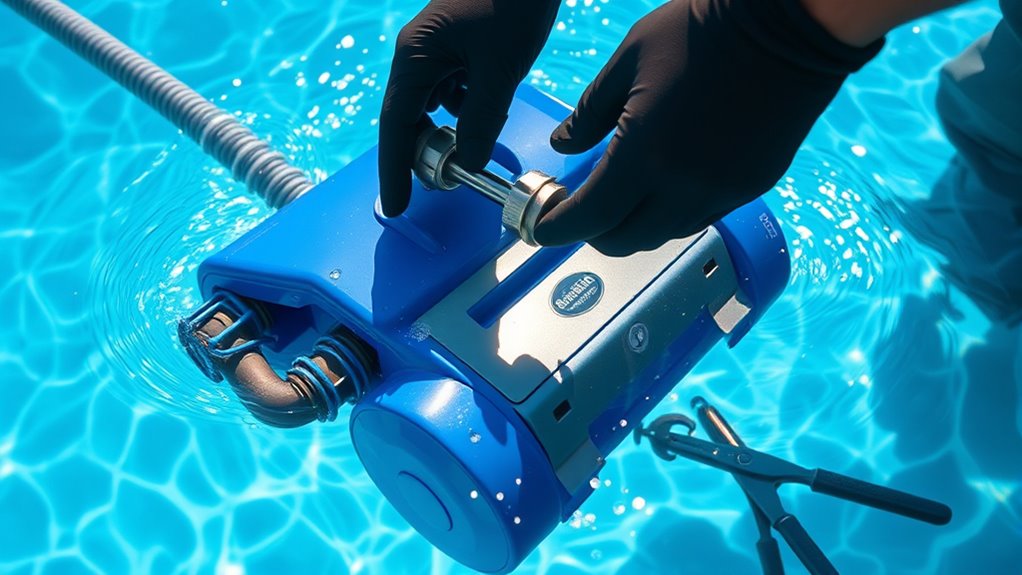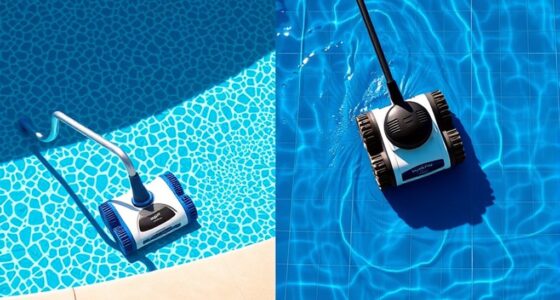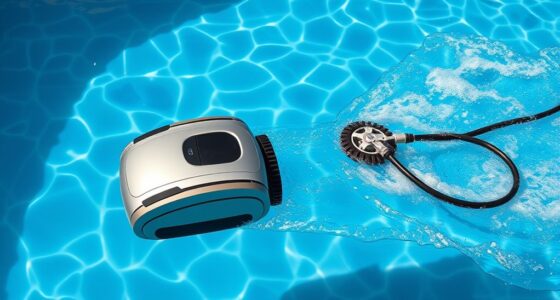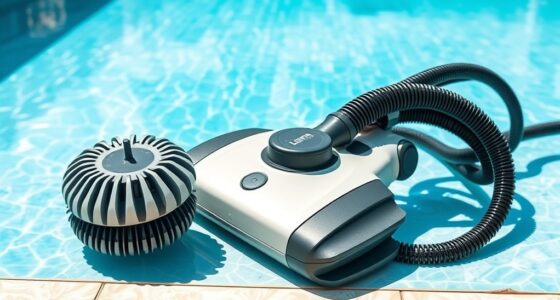If your automatic pool cleaner isn’t working properly, start by checking the power supply, connections, and valves to make certain of proper flow and suction. Inspect the brushes and tracks for wear or misalignment, and clean or replace filters and skimmer socks as needed. Make sure the navigation system moves smoothly and the water conditions are balanced. Investigate the pump and suction lines for blockages. For more tips, follow along to ensure your cleaner performs at its best.
Key Takeaways
- Check power supply, connections, and valves to ensure proper operation and flow.
- Inspect and replace worn brushes and tracks for smooth movement.
- Verify navigation functions and water conditions for efficient cleaning coverage.
- Clean filters, skimmer socks, and inspect hoses to maintain suction and water flow.
- Examine the system for leaks, check control panel codes, and adjust settings as needed.
Checking the Power Supply and Connections
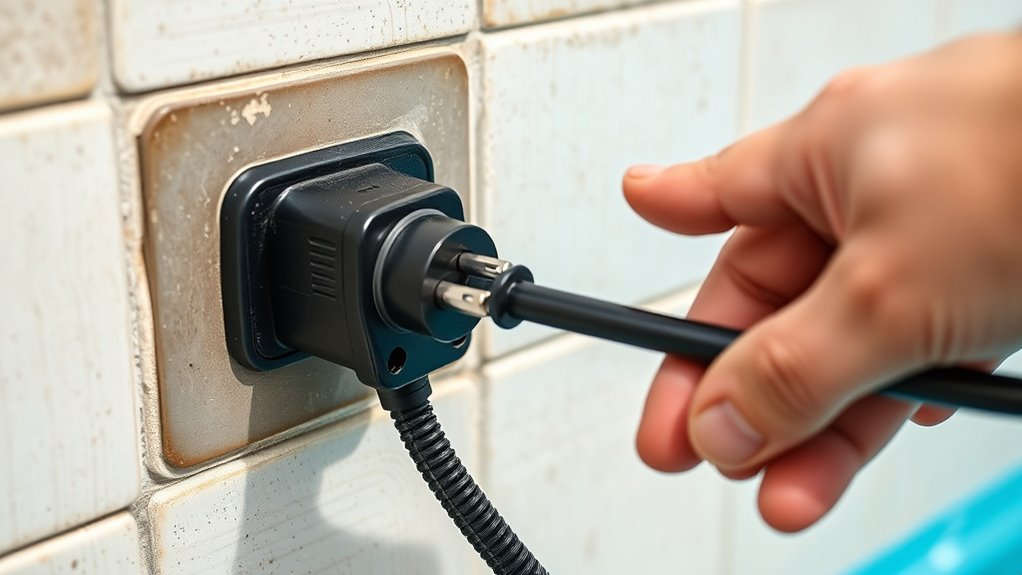
Before troubleshooting your automatic pool cleaner, you should first verify it’s receiving power. Check the power outlet and ensure your cleaner is plugged in securely. Power surges can trip your circuit breaker, cutting off power unexpectedly. Locate your home’s circuit breaker panel and see if the breaker controlling the pool system has flipped to the off position. If it has, reset it by switching it off and then back on. Also, inspect the outlet for any signs of damage or loose wiring. Sometimes, a simple power surge can cause a breaker to trip, so resetting it may restore power. Confirm that the power source is functioning properly before moving on to other troubleshooting steps. This guarantees your cleaner is getting the necessary electricity to operate. Additionally, ensuring the power supply is stable and consistent helps prevent future issues. Regularly checking your electrical connections can help identify potential problems early and maintain reliable operation. To further safeguard your system, consider installing a surge protector to help prevent damage from unexpected power fluctuations. Moreover, incorporating data-driven strategies can assist in diagnosing recurring power issues more effectively.
Inspecting the Cleaner’s Brushes and Tracks
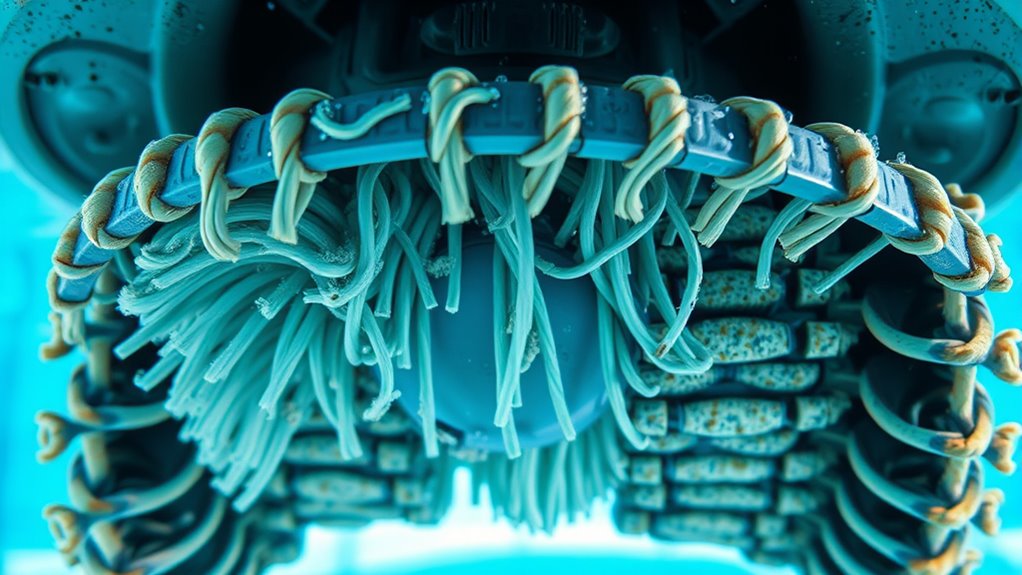
Start by checking the brushes for signs of wear or damage, as worn brushes can reduce cleaning efficiency. Regularly inspecting the brushes helps maintain optimal performance and prolongs their lifespan. Additionally, choosing the right performance upgrades can further enhance your cleaner’s effectiveness. Next, examine the tracks to make sure they’re properly aligned and moving smoothly across the pool surface. If you notice any broken or bent parts, replace them promptly to keep your cleaner working effectively. Additionally, ensuring the tracks are properly aligned and maintained can help prevent unnecessary wear and improve overall performance. Proper maintenance of these components is essential for automation’s role in business intelligence, which emphasizes the importance of continuous monitoring for optimal results.
Check Brush Wear
To keep your automatic pool cleaner working efficiently, you need to regularly check its brushes and tracks for wear. During wear inspection, look for signs of thinning, cracking, or missing bristles. Worn brushes can reduce cleaning effectiveness, so consider brush replacement if they’re markedly damaged. Additionally, inspecting the self-watering system of your pool cleaner can help identify any potential blockages or malfunctions that may affect performance. Regular maintenance, including filter replacement, is essential to prevent debris buildup that can hinder operation. Incorporating advanced machine learning algorithms can assist in predicting component wear and scheduling timely maintenance. Furthermore, understanding affiliate marketing disclosures and how they relate to product recommendations can help you make informed choices about replacement parts. Properly inspecting and maintaining these components aligns with best practices in yoga practice for overall well-being and efficiency. Key points to remember include:
- Check for uneven wear or smooth spots on the brushes
- Look for cracks, chunks missing, or excessive fraying
- Inspect the bristles’ length and firmness
If the brushes are visibly worn or damaged, replacing them will restore proper movement and dirt removal. Regular wear inspection helps you catch issues early, preventing decreased performance or damage to the tracks. Keeping brushes in good condition is essential for ideal cleaning.
Examine Track Alignment
Have you noticed your cleaner isn’t moving smoothly or covering the pool effectively? It could be a track alignment issue. Start by inspecting the tracks for proper tread alignment; misaligned tracks can cause skipping or uneven cleaning. Check the track tension—if it’s too loose, the tracks may slip, while overly tight tension can hinder movement. Ensure the tracks sit evenly on the wheels and aren’t twisted or bent. Adjust the tension if needed, following your cleaner’s instructions. Proper track tension and alignment are crucial for maximum performance, preventing unnecessary wear and tear. Regularly inspecting the track alignment and maintaining proper tension will extend the lifespan of your pool cleaner. Additionally, keeping the tracks free from debris and buildup can prevent further issues. Using proper maintenance techniques will help keep your cleaner operating efficiently. It’s also helpful to consult your manufacturer’s guidelines to understand specific adjustments for your model. Correct track alignment ensures your pool cleaner moves efficiently across all surfaces. Moreover, reviewing your model’s manufacturer guidelines can provide specific troubleshooting tips to optimize track performance.
Replace Damaged Parts
If you notice your pool cleaner isn’t performing well despite proper track alignment, inspecting and replacing damaged parts like brushes and tracks can often resolve the issue. Damaged brushes can prevent proper debris removal, while worn tracks may cause skipping or incomplete cleaning. During seasonal maintenance, check for cracks, tears, or excessive wear. Also, ensure your pool’s chemical balance is ideal, as imbalances can affect cleaner performance. Proper retail hours can help you plan your maintenance visits more effectively.
To troubleshoot, consider these steps:
- Inspect brushes for cracks, missing bristles, or dullness
- Examine tracks for tears, debris buildup, or misalignment
- Replace damaged parts promptly to restore efficiency
Regularly maintaining these parts, especially after heavy use or seasonal changes, helps your cleaner perform at its best.
Cleaning or Replacing the Filter and Skimmer Socks
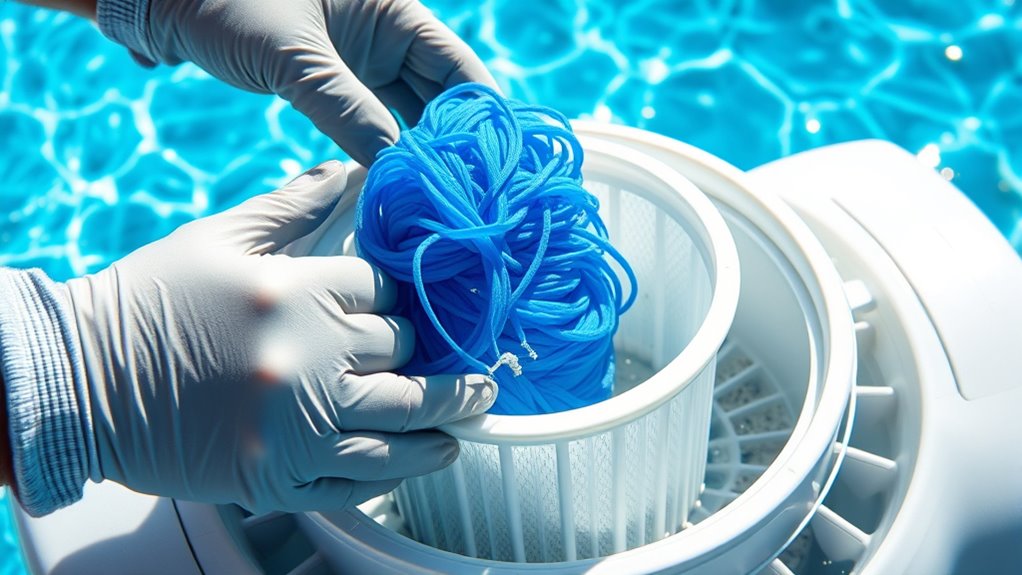
Cleaning or replacing the filter and skimmer socks is a crucial step in maintaining your automatic pool cleaner’s efficiency. Dirty filters hinder filter maintenance, reducing suction and cleaning power. Skimmer sock replacement prevents debris buildup that can clog the cleaner. Regular checks ensure ideal operation. Additionally, proper maintenance procedures help prolong the lifespan of your equipment. Keeping these components clean also reduces the risk of clogged filters, which can cause your cleaner to work less effectively. Staying attentive to these components supports optimal performance and prevents costly repairs.
Ensuring Proper Navigation and Coverage
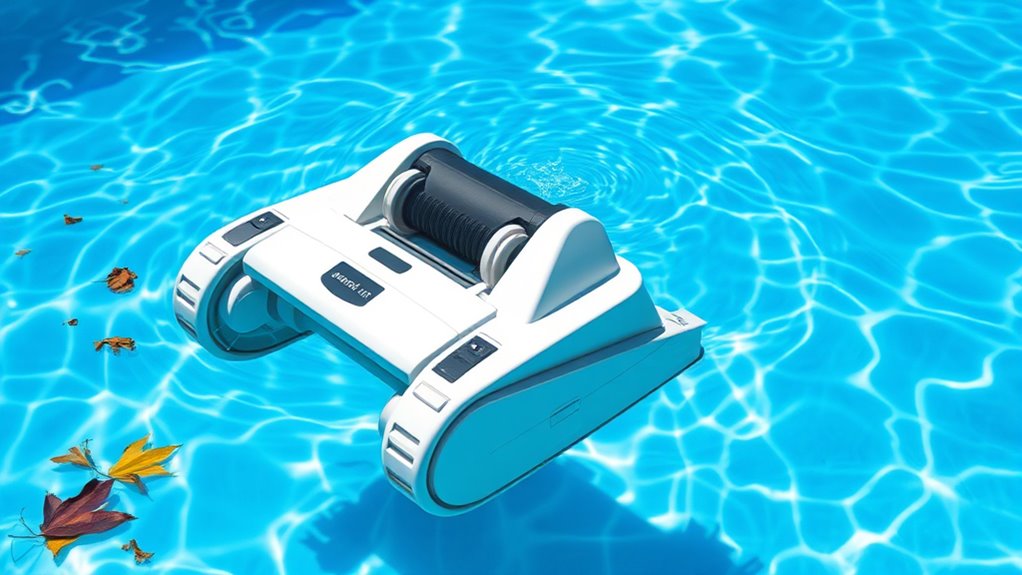
After confirming your filter and skimmer socks are clean and functioning properly, the next step is to verify that your automatic pool cleaner is steering your pool effectively. Proper navigation depends on several factors, including pool chemical balance and water temperature, which can influence cleaner performance. You should check for the following:
- Make sure the water is balanced; imbalanced chemicals can cause debris to stick or hinder movement.
- Confirm water temperature is within the cleaner’s operational range, as extreme temperatures may affect motor function.
- Ensure the cleaner’s wheels or tracks aren’t obstructed and are turning freely for optimal coverage.
Addressing these points helps your cleaner navigate efficiently, ensuring thorough coverage and preventing missed spots. Proper water conditions and maintenance are key to troubleshooting navigation issues effectively.
Troubleshooting the Pump and Suction Lines
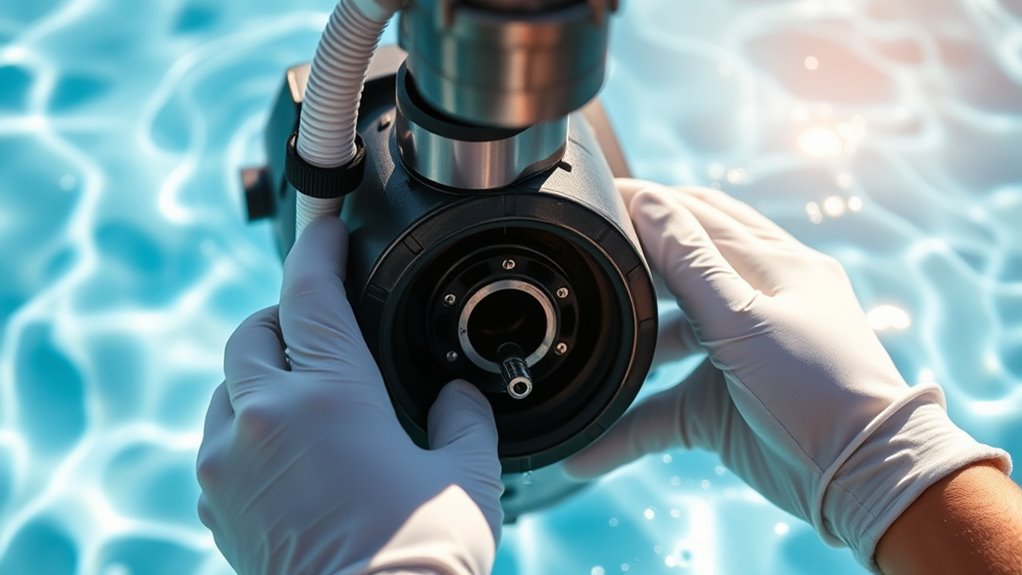
When your pool cleaner isn’t working properly, start by inspecting the pump and suction lines for blockages that could hinder water flow. Next, check for leaks that might reduce suction and impair performance. Finally, verify that the valves are functioning correctly to make sure everything operates smoothly.
Inspect for Blockages
If your automatic pool cleaner isn’t functioning properly, the first step is to check for blockages in the pump and suction lines. Debris accumulation can restrict water flow, reducing cleaning efficiency. Also, inspect the hoses for kinks, which can impair suction. Look for:
- Debris buildup inside hoses or fittings
- Kinks or twists in the hoses
- Obstructions in the pump or skimmer basket
Clear out any debris carefully and straighten hose kinks. Ensure all connections are secure and free of obstructions. Taking these steps helps restore proper water flow, preventing future issues with your cleaner’s performance. Regular inspection of these areas keeps your pool cleaner running smoothly and prolongs its lifespan.
Check for Leaks
Are you noticing a decrease in your automatic pool cleaner’s performance? Leak detection is essential to identify if your pump or suction lines are compromised. Begin by inspecting the pipes and fittings for visible cracks, holes, or loose connections. Leaks can occur if pipe integrity is compromised, causing pressure loss and reduced suction power. Listen for hissing sounds or observe if water levels drop faster than usual, which signals a leak. Use soapy water to spray connections and check for bubbling, indicating escaping air or water. Addressing leaks quickly helps restore *ideal* operation and prevents further damage. Ensuring pipe integrity through thorough leak detection keeps your cleaner functioning efficiently and extends the lifespan of your pool system.
Verify Valve Operation
To guarantee your pool cleaner functions properly, verify that all valves are operating correctly. Valve malfunction can disrupt flow regulation, causing poor cleaning performance. Check that the valves are fully open or closed as needed and move smoothly without sticking. Misaligned or damaged valves can restrict water flow, leading to suction issues.
- Confirm valves are fully open for proper flow regulation
- Inspect for signs of valve malfunction, such as leaks or resistance
- Ensure valves move freely without sticking or resistance
Address any irregularities immediately to maintain proper suction and flow. Proper valve operation ensures your pump and suction lines work efficiently, preventing flow disruptions that could hinder your automatic pool cleaner’s performance.
Examining the Control Panel and Settings
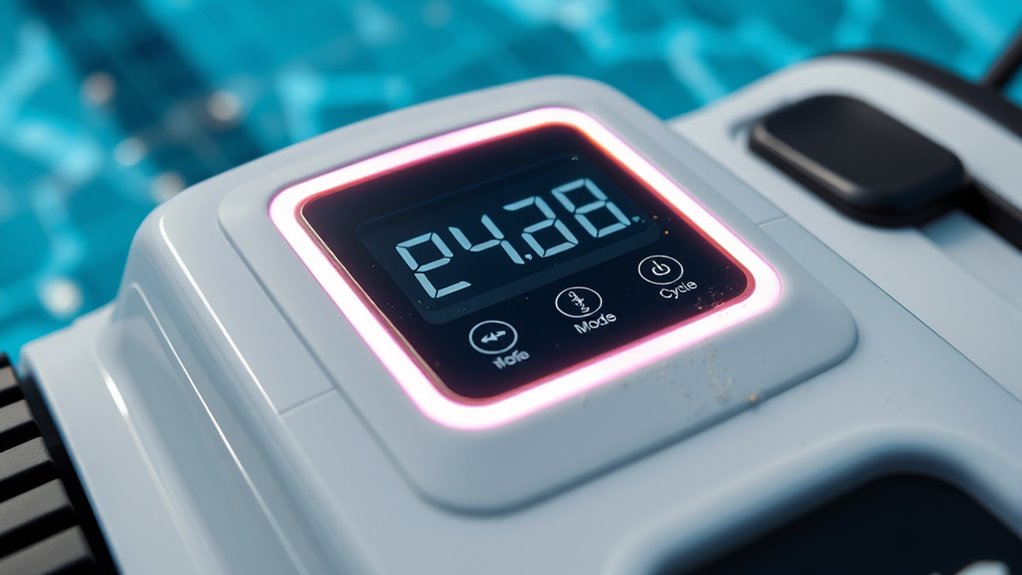
Inspecting the control panel and settings is an essential step in troubleshooting your automatic pool cleaner. Begin by checking the control panel diagnostics to identify any error codes or warning lights that can pinpoint specific issues. Verify that all settings are correctly configured for your pool size and cleaning cycle. Sometimes, accidental adjustments can cause the cleaner to malfunction or skip areas. Make sure the timer, cleaning mode, and cycle length are properly set. If you notice any irregularities or unfamiliar codes, consult the manufacturer’s manual for guidance. Adjust the settings as needed, and then restart the system to see if the problem resolves. Properly examining the control panel helps you quickly identify and correct configuration issues that could impair your cleaner’s performance.
Addressing Common Mechanical and Wear Issues
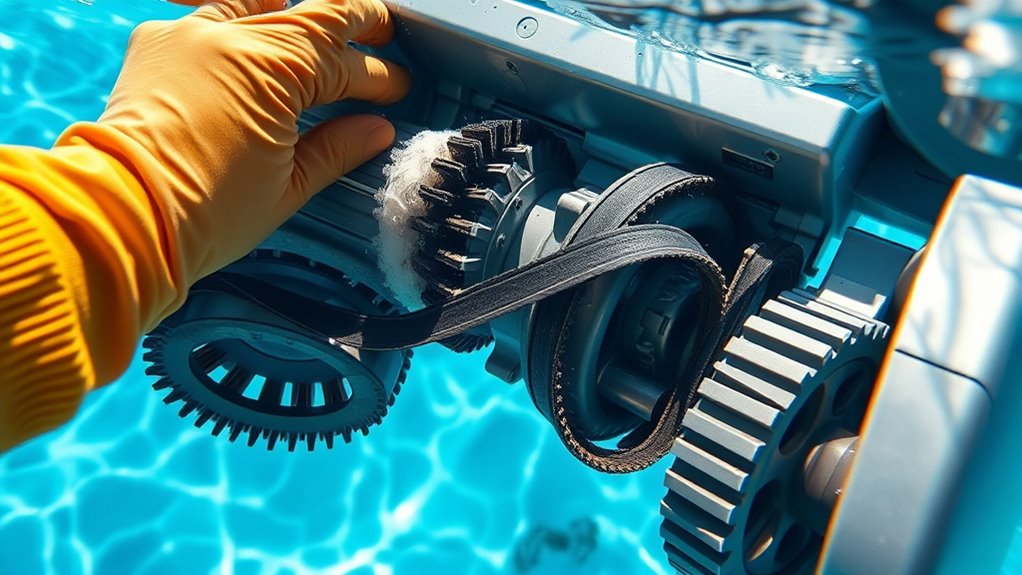
Mechanical and wear issues are common causes of automatic pool cleaner malfunctions. Over time, parts like brushes, wheels, and tracks can deteriorate due to regular use and seasonal maintenance lapses. To troubleshoot, check for broken or worn components and replace them as needed. Poor pool chemistry can accelerate wear, so maintaining proper chemical levels helps extend your cleaner’s lifespan. Regularly inspecting and cleaning the parts prevents build-up and ensures smooth operation. Here are key areas to examine:
- Brushes and wheels for cracks or damage
- Hoses and seals for leaks or clogs
- Drive belts or tracks for wear and proper tension
Addressing these issues promptly keeps your cleaner running efficiently and reduces costly repairs, especially during seasonal changes when maintenance is most important.
Frequently Asked Questions
How Often Should I Perform Routine Maintenance on My Pool Cleaner?
You should perform routine maintenance on your pool cleaner at least once a week to keep it running smoothly. Follow your cleaning schedules and stick to regular maintenance tips like cleaning filters, checking brushes, and inspecting hoses. This guarantees peak performance and longevity. Regular maintenance helps prevent problems, so don’t skip these steps. By staying consistent, you’ll enjoy a cleaner pool and fewer issues with your automatic pool cleaner.
Can Debris Blockages Cause the Cleaner to Operate Improperly?
Did you know that debris blockages are responsible for nearly 60% of automatic pool cleaner malfunctions? When debris gets lodged in the cleaner, it can hinder movement and reduce effectiveness. Frequent debris blockages may also cause impeller damage over time, leading to costly repairs. To keep your cleaner running smoothly, regularly check for obstructions, clear debris, and inspect the impeller for damage. Proper maintenance prevents issues before they start.
What Safety Precautions Should I Take When Servicing the Cleaner?
When servicing your automatic pool cleaner, you should prioritize electrical safety by unplugging it before starting. Avoid contact with water or electrical components to prevent shocks. Also, be mindful of chemical precautions; wear gloves and protective eyewear if handling any cleaning agents or chemicals. Keep the area dry, and make certain the power source is off. These precautions help keep you safe while maintaining your cleaner effectively.
How Do I Reset the Cleaner After Troubleshooting?
Think of resetting your cleaner like rebooting a computer after troubleshooting steps. To perform a manual reset, turn off the power supply, wait a few seconds, then turn it back on. This clears any glitches. If needed, press the reset button on the cleaner or unplug it for a moment. This simple step helps the device restart fresh, ensuring your troubleshooting efforts take effect and your cleaner runs smoothly again.
Are There Specific Signs Indicating Imminent Mechanical Failure?
You might notice sensor malfunctions or motor overheating as signs of imminent mechanical failure in your pool cleaner. If the sensors stop responding or give false readings, it’s a red flag. Similarly, if the motor overheats or makes unusual noises, it’s likely nearing failure. Address these issues promptly by inspecting and maintaining your cleaner, as ignoring these signs can lead to more costly repairs or complete breakdowns.
Conclusion
By following these troubleshooting steps, you’re like a skilled captain steering your pool cleaner through calm and stormy waters alike. When you check connections, inspect brushes, and guarantee proper navigation, you’re guiding your device back to smooth sailing. Remember, a well-maintained cleaner isn’t just working—it’s dancing effortlessly across your sparkling pool, turning what once felt like a puzzle into a simple breeze. With a little attention, your pool will shine brighter than ever.
